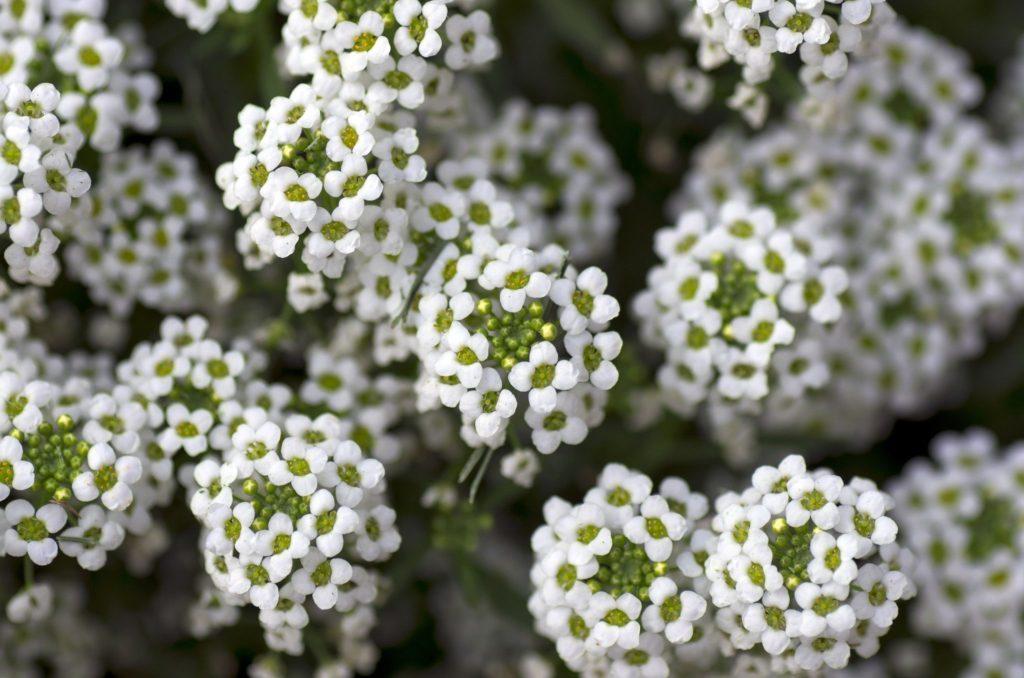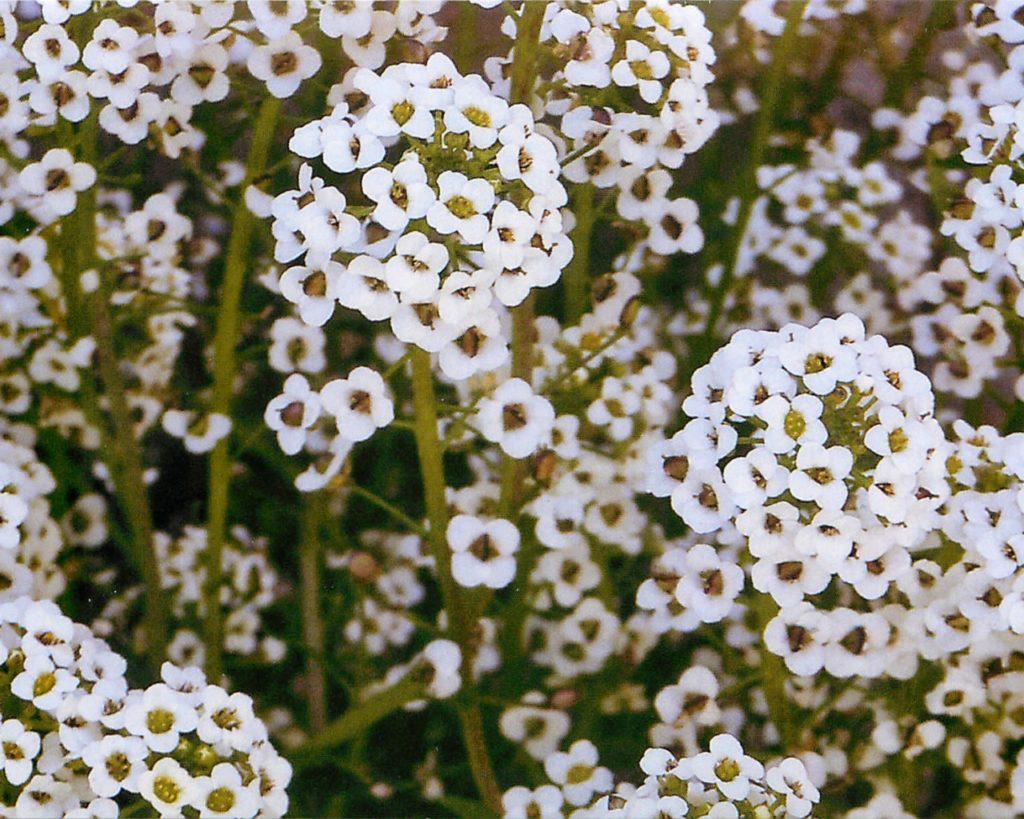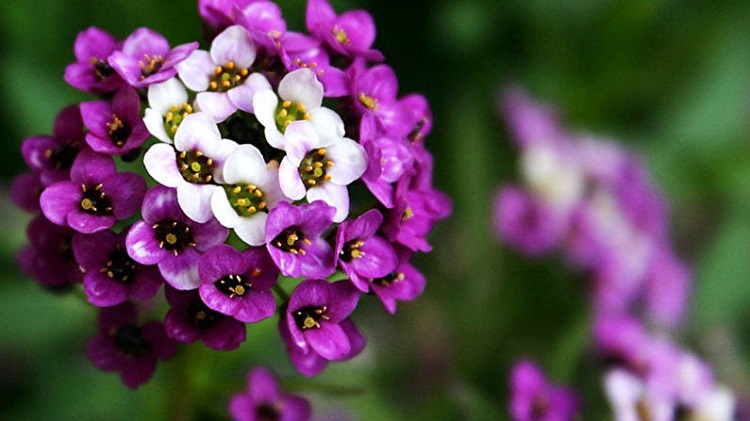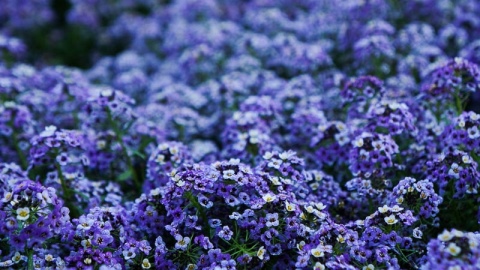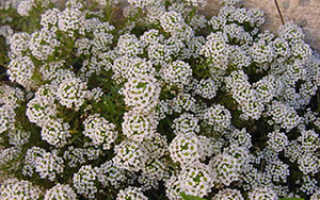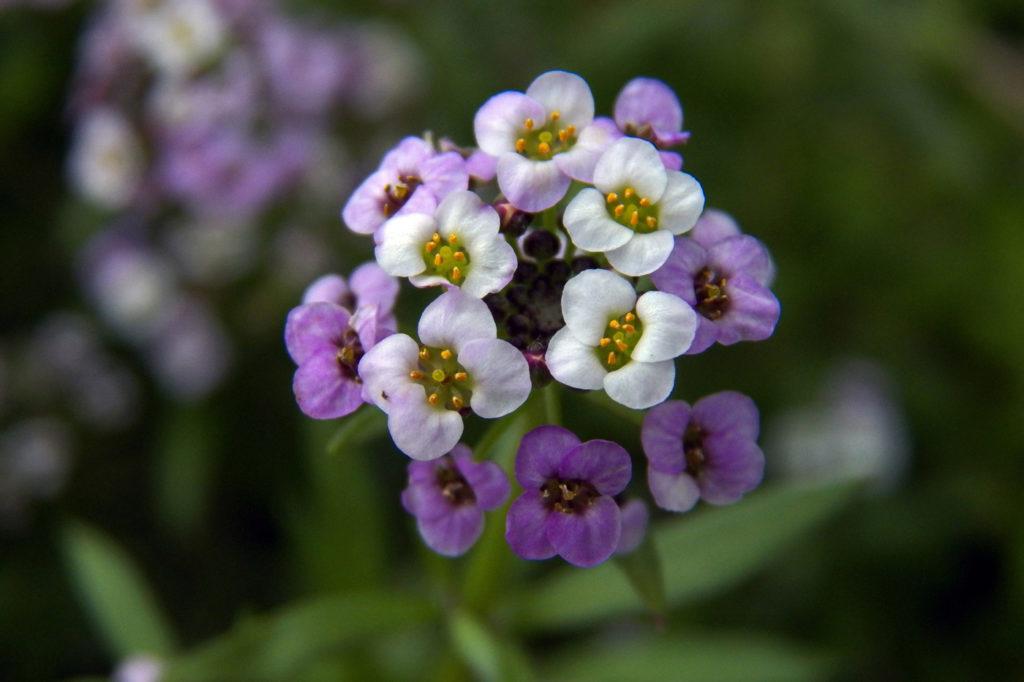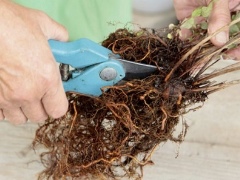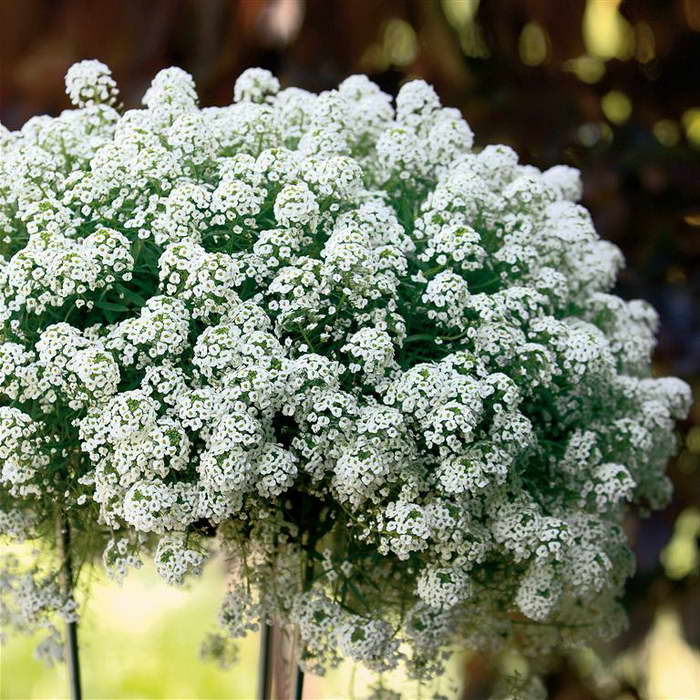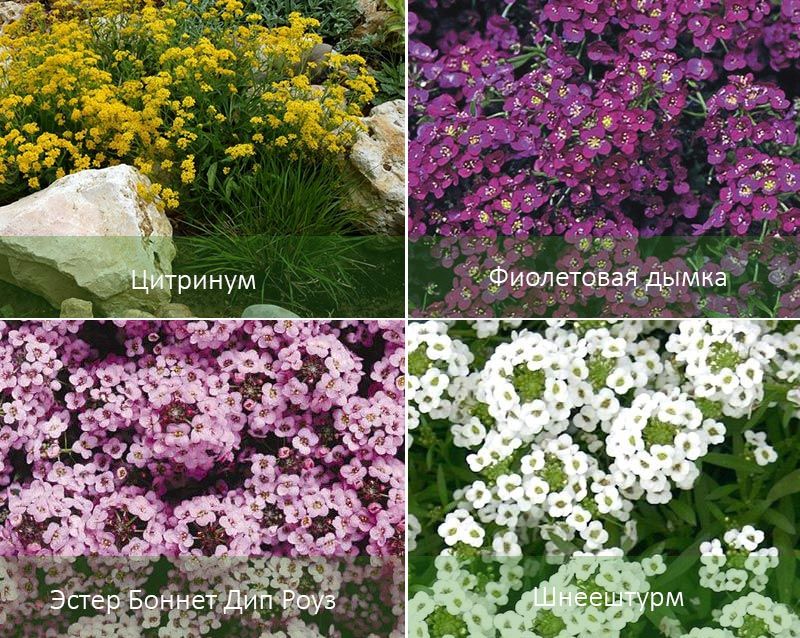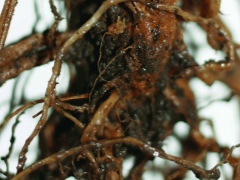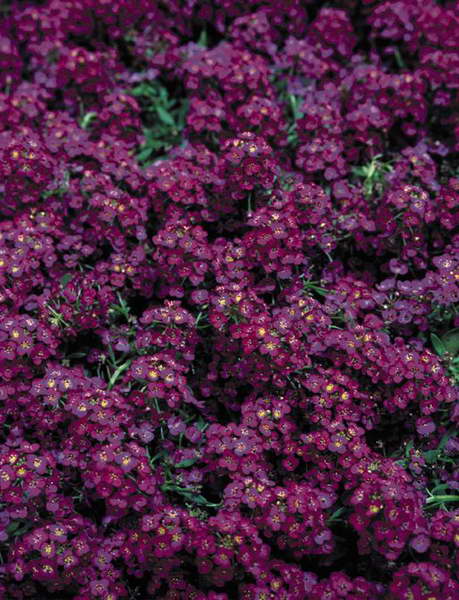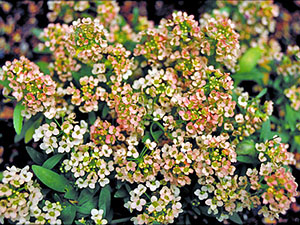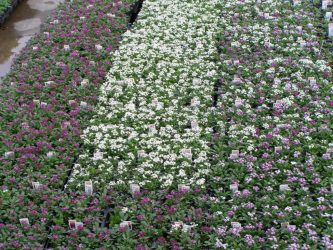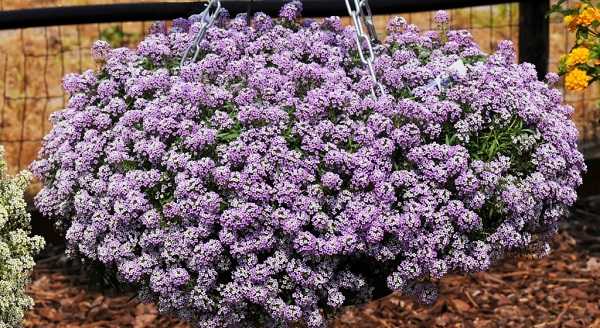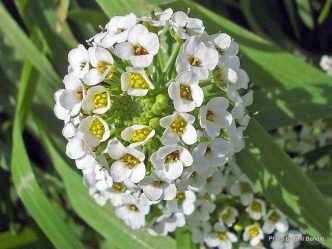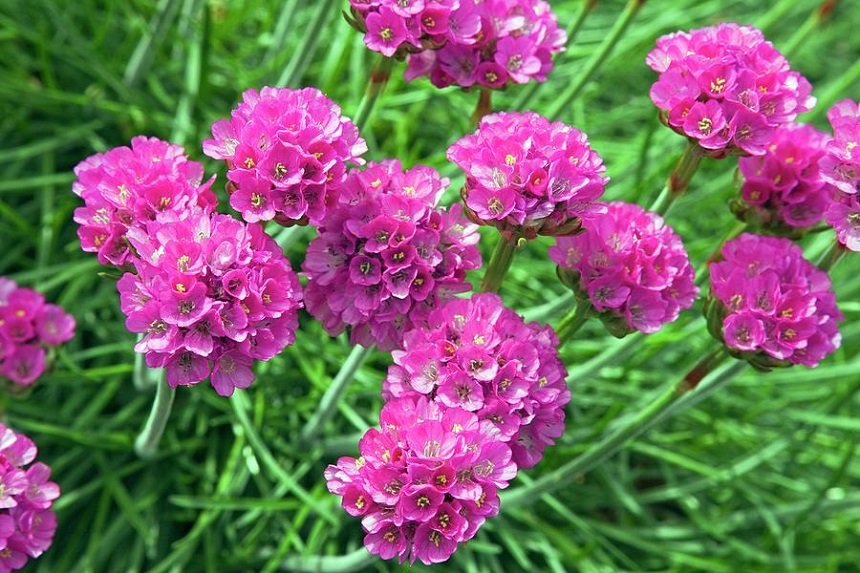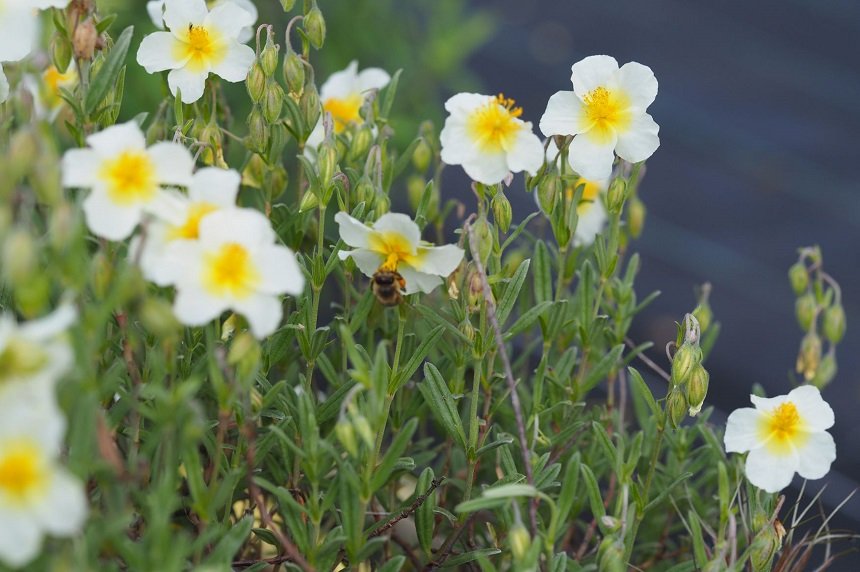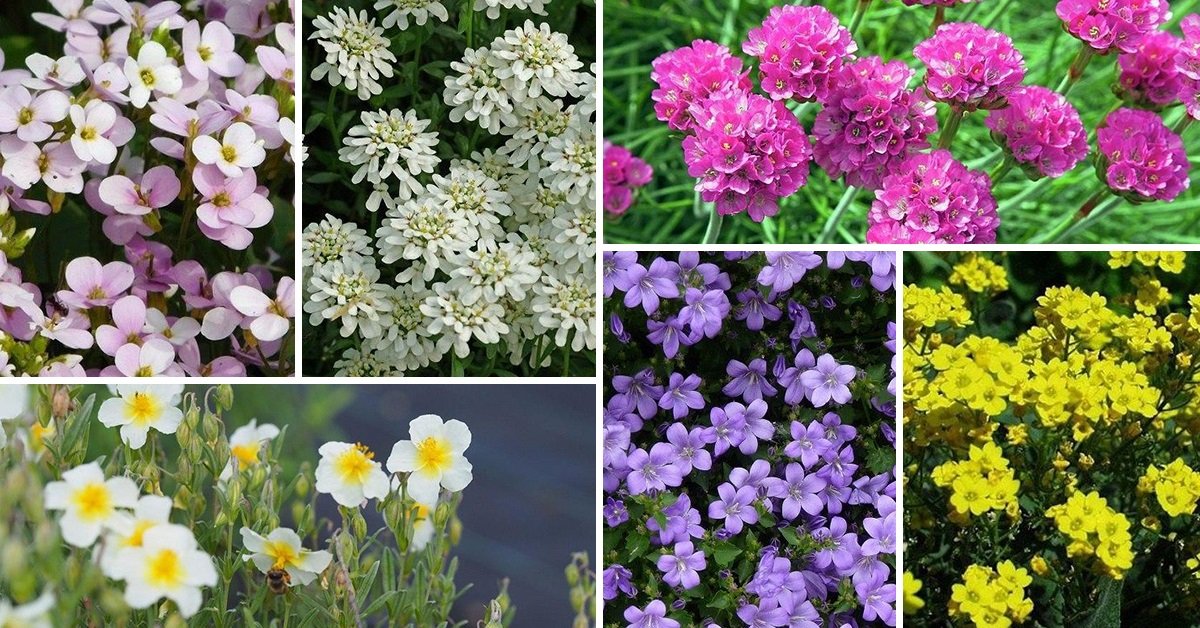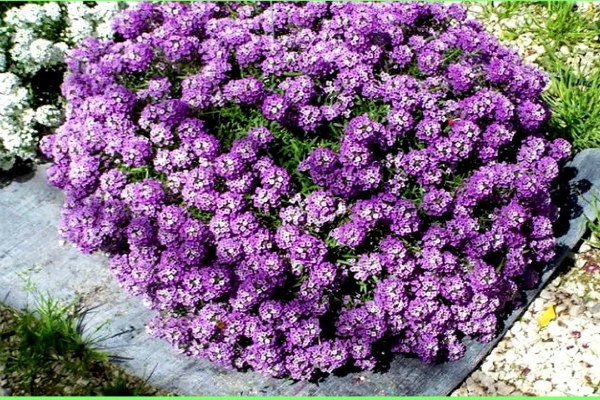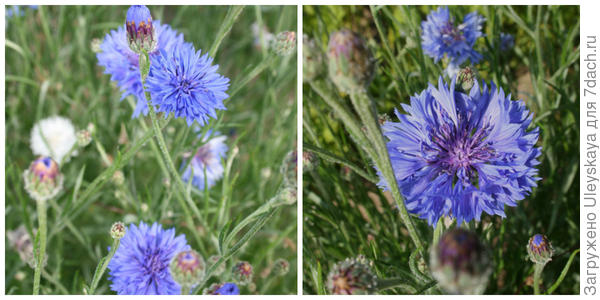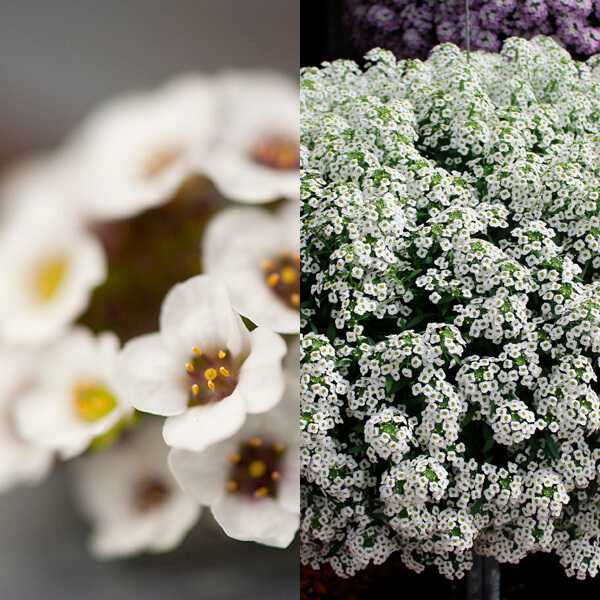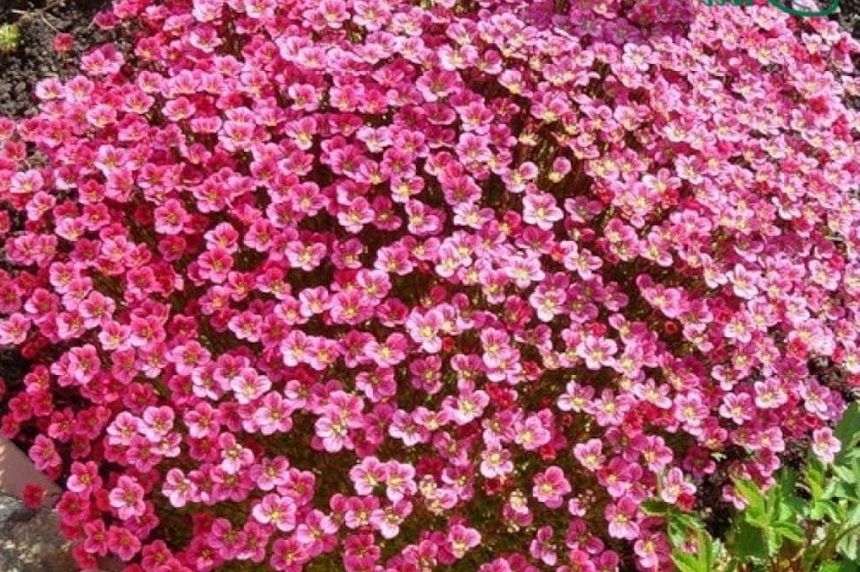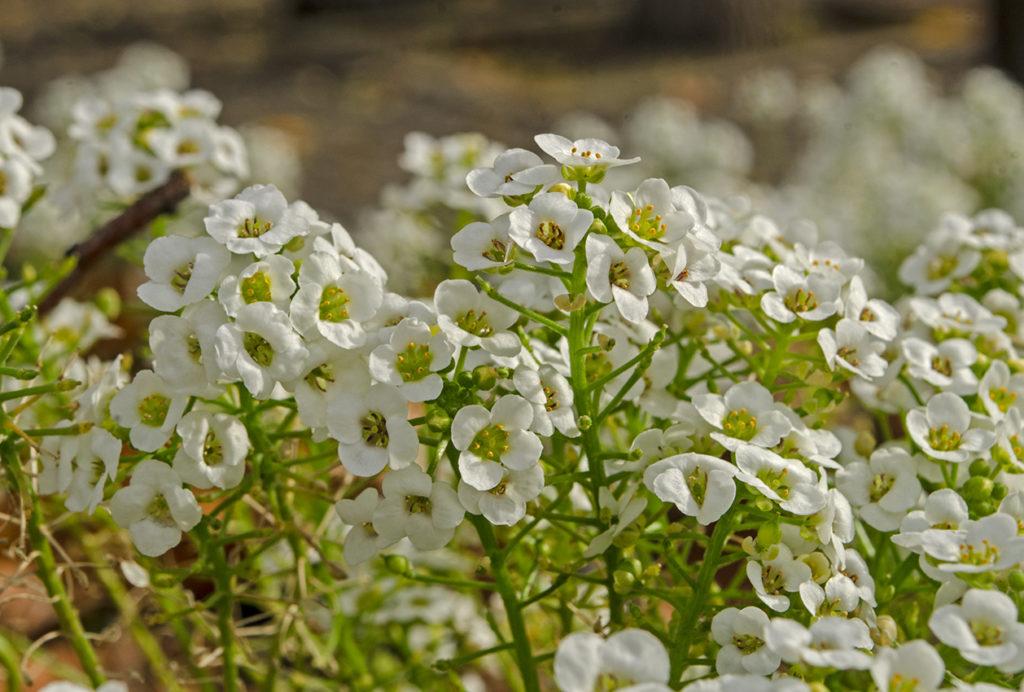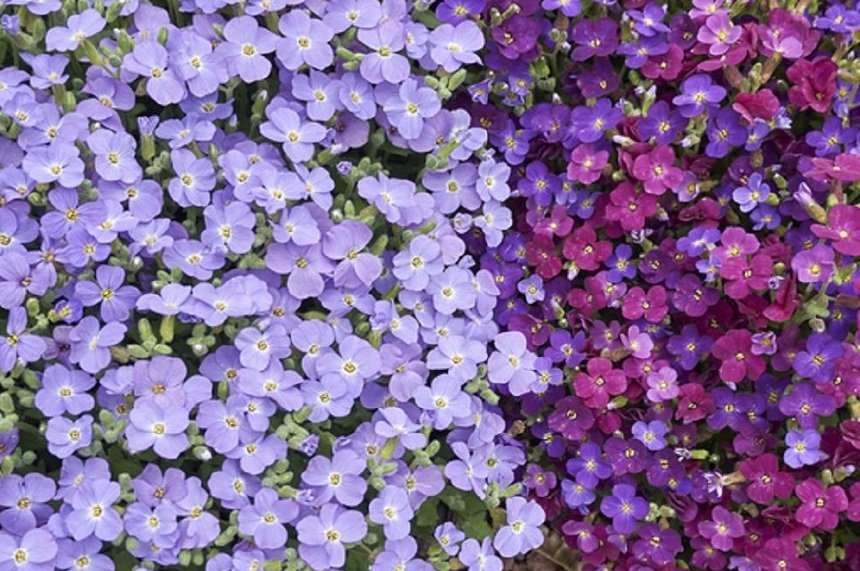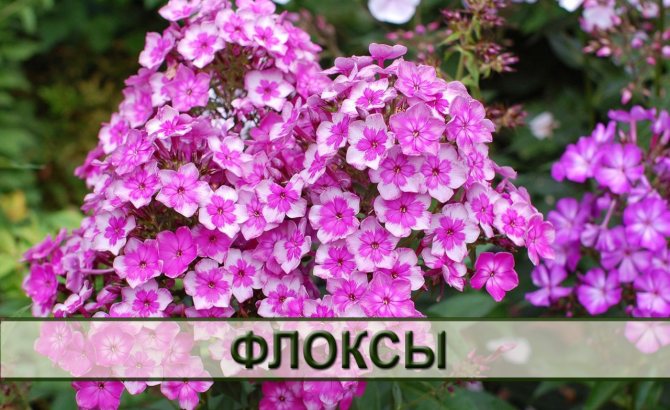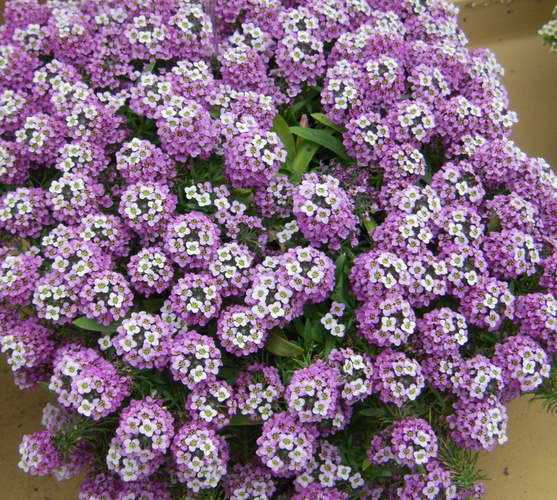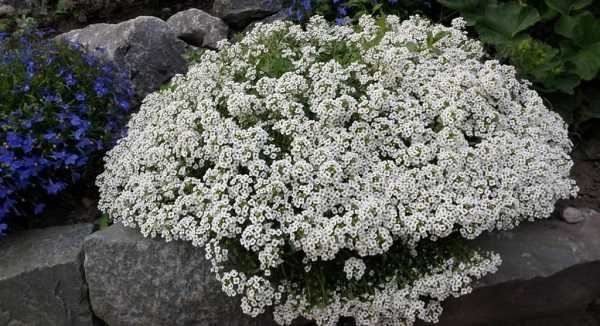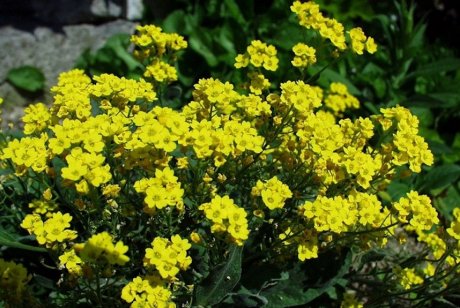Alyssum: planting and care in the open field
Picture 6. Seedlings of alyssum
The area where the plant is planned to be planted must be dry and well-drained. Poor conditions for a flower give acidic and waterlogged soils.
The plant can grow on poor soil with neutral acidity. Such land will allow moisture to not linger in the soil.
There are two ways of propagation of alyssum: cuttings and seeds (for seedlings and in open ground). Let's take a closer look at all the methods.
Step-by-step process of planting seedlings
Many growers prefer to grow seedlings, as this is the most effective method.
To plant seedlings you need:
- Buy light and nutritious soil. It must contain lime. Acidity 5.5-6.2.
- The seeds are planted in March-April. You need to take a landing box. Fill it with soil. Place seeds on top. They should not be stacked very densely, as this will reduce the likelihood of seedlings. Top of the seeds are sprinkled with soil. Perhaps just deepen them with your finger.
- The container is covered with foil or glass. This is done in order to create a greenhouse. The box is placed in a well-lit place. It is necessary to moisten the earth moderately. It is also imperative to ventilate the seeds for a while. If all conditions are met, the seed will germinate in a week.
- It is necessary to dive seedlings when 2-3 leaves grow. If the plant is actively growing, then this procedure should not be carried out at all.
Important! In early May, seedlings must be hardened on the balcony. Then, at the end of May, it is planted in open ground, in a selected area
Alyssum: growing by seeds in the open field
The seeds can be purchased at the store or harvested on your own. It is better to purchase them in the store, as they undergo special processing.
Sowing seeds is necessary taking into account the following requirements:
- It is necessary to plant planting material when the soil is well warmed up. This happens at the end of May.
- The seeds are processed before planting. To do this, they are soaked in a weak solution of manganese. This procedure will protect them from diseases and pests.
- Small grooves are created in the soil. Their depth should be no more than 1.5 cm. They can be planted often. After emergence, thinning is performed.
Propagation by cuttings
Vegetative reproduction of alyssum is carried out less often. To do this, several cuttings are cut from the plant. Then they are placed in water.
Rooting can also be done in a pot with soil. In autumn, shoots are planted in open ground.
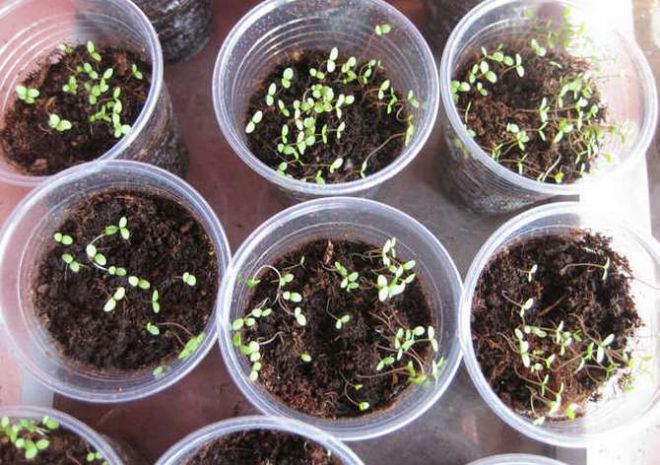
Alyssum seedlings
Outdoor care
Long and laborious care for alisum is not required. It consists in watering, feeding, loosening, removing excess litter and cutting. The flower can grow in drafts, stony soils, arid areas, and also easily coexists with other plants.
The bushes of the plant grow rapidly in width. In this regard, the plants should be planted at a distance of 15-20 cm from each other.
With proper cultivation and care of alyssum, it is necessary to regularly trim the plant. This will enhance growth and bloom more lush. Up to 8 cm shoots are removed. To carry out anti-aging pruning after the flowers have wilted, it is necessary to shorten the shoots by 1/3.
Water the plant in moderation. The flower is sensitive to waterlogging of the soil, but it also begins to dry out from drought. If there is a lot of precipitation, then there is no need to water the plant. In dry periods, the plant especially needs moisture.
Watering is required to be plentiful, but it is impossible to allow stagnation of moisture in the soil.To make the soil more permeable, it is necessary to loosen it after each watering.
Attention! To find out whether to water the plant, you can dig the ground to a depth of 4 cm.If the ground turns out to be dry, then you can safely water it
During the season, the plant must be fed twice. For the first time, this is done in the spring with nitrogen-containing fertilizers. The second time the flower is fed before flowering with mineral fertilizers. Liquid formulations are applied at the root. They must not fall on flowers or leaves.
Outdoor cultivation
Growing alissum in the open field also provides for a number of agrotechnical measures. You should start with disembarkation. Prepare the soil first. To do this, you need to add humus and complex mineral fertilizer to the site, dig up or loosen the soil. Then make the markup. Alyssum seedlings should be planted in open ground according to the 40 x 40 cm scheme. For planting, a hole is prepared up to 20 cm deep. The root system and about 2 cm of the aboveground part are lowered there to improve the condition of the roots. Drizzle with plenty of warm water. Dig in. Top for the adaptation period can be covered with a special covering material.
The next important agrotechnical operation is the formation of a bush. The first pinching is done in the seedling stage. The second pruning is carried out after planting in the ground, when the shoots have reached a length of 10 cm. Shorten all of them by 2 - 3 cm to stimulate lateral branching. The following pruning is carried out in order to form the desired shape of the plant. An autumn flower scapular can be used to obtain cuttings.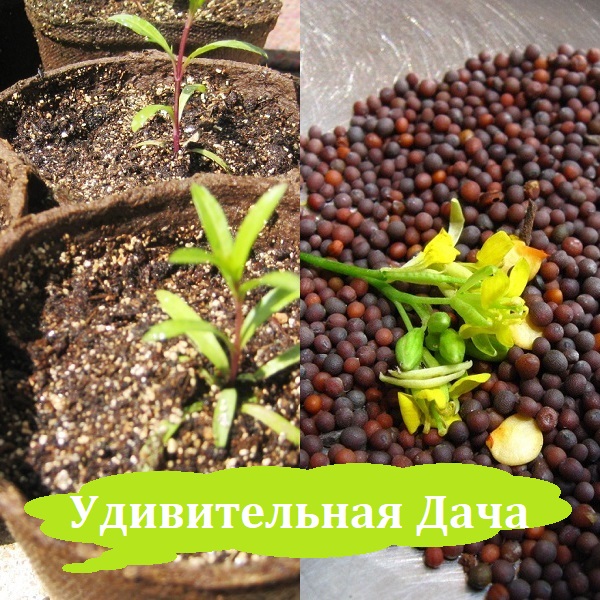
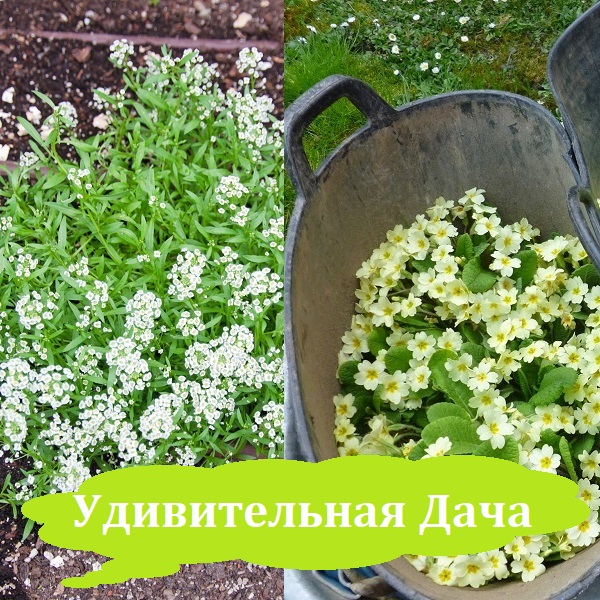
Seed collection and preparation for wintering
Preparation for wintering is either covering the bushes in the ground, or moving them to protected ground conditions. They can winter in heated greenhouses and indoors. Transplants as mother cells are carried out in mid-September. The plant is dug up and transferred to fresh soil in a planter. If alyssum was grown in a hanging planter, it is enough just to bring it into the house.
A shelter for the winter can be built from spruce branches or straw
It is important to remove it in the spring for the moment the snow cover disappears. Otherwise, the plant will die from damping.
What to combine with on the site?
Growing alissum seedlings from seeds opens up wide horizons for using the plant on the site. What to combine it with for the perfect effect? The flower looks great as a border and flower garden decoration. It can be planted in ampels and on slides, as a groundcover between tall flowers.
It is recommended to use a contract effect, for example, white alyssum used as a background for orange marigolds or purple asters. Compositions with such flowers as: red tulip, rezuha, bearded dwarf iris, Belvedere rose, forest forget-me-not, pelargonium, obrietta, Turkish carnation, Viola Vittrok, heliotrope, phlox look perfect.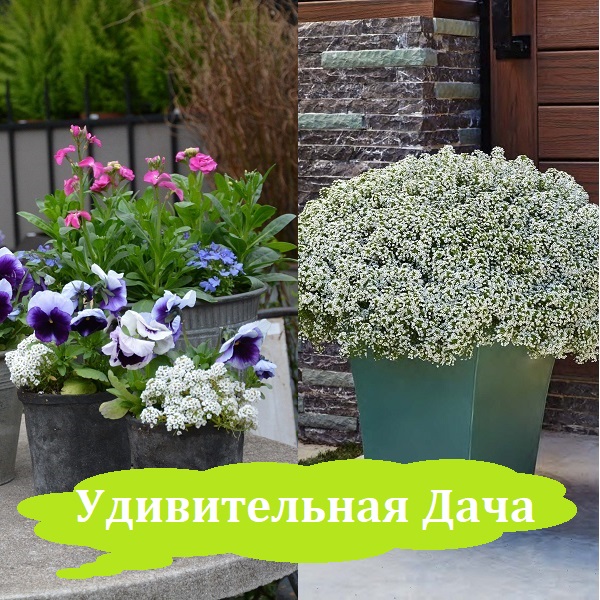
Reproduction of alissum
You can propagate the beetroot by seeds, cuttings or dividing the bush.
- Reproduction by seeds. For propagation by seeds, seeds are harvested in autumn, which are stored in paper bags until spring. In the spring, they are sown on a fertile soil mixture with the addition of lime and, without covering from above with soil, covered with glass or film and placed in a warm, bright place. The film is regularly lifted to ventilate and remove condensation moisture. After the emergence of friendly shoots, the film is removed. It should be borne in mind that the sprouts are very fragile and can easily break, so they should be moistened with a spray bottle. After 3-4 true leaves appear on the seedlings, they dive into the pots. When the sprouts reach 10 cm in height, the tops are pinched so that the bush forms branched. After two to three weeks, the seedlings are planted in open ground. If you sow seeds directly into the ground in spring or fall, you don't need to dive or plant. Such seedlings will begin to bloom much earlier.An important condition is sowing seeds at a time when the soil has warmed up sufficiently in the spring or has not yet cooled down in the fall. This is the end of September or the beginning of May. After sprouts appear, they should be systematically moistened and loosened up the soil to prevent the formation of an earthen crust. When the seedlings germinate enough, they are thinned so that the distance between the bushes is 15-20 cm.
- Propagation by cuttings. For propagation, cuttings are cut into cuttings 10-15 cm long. The lower cut is slightly dried and buried in fertile soil by 2-3 cm. A bag or cut plastic bottle is placed on top of the pot. The cuttings are regularly moistened. When the shoots acquire a green color, this will signal their rooting. A week or two after the formation of the roots, the cuttings are planted in a permanent place of growth.
- Reproduction by dividing the root. This method is considered the fastest and most effective. To carry it out, an adult bush is removed from the ground and divided into several pieces with a sharp object. Each piece is planted in a separate pre-prepared place. Most often, overgrown bushes are chosen for such reproduction.
Use in garden design
Lobularia of white, purple, mixed shades is loved by garden designers. Due to its neutral color, it is indispensable as a curb crop. With its help, they border lawns, paths, mixborders.
In rabatki it is used as a ground cover plant, acting as a background for bright spots of flowering annuals and perennials. For the same purposes, it is planted in relief flower beds - rock gardens, rockeries.
Lobularia of a light purple hue resembles star pearls, goes well with other border cultures of warmer, more saturated colors - marigolds, nasturtium, undersized zinnia.
An annual planted in a container forms a ball, densely strewn with flowers and smelling of honey. Looks spectacular in vertical gardening of balconies, terraces, patios. 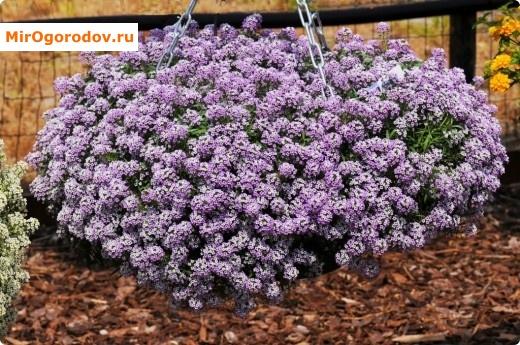
In the photo, Primorskaya lobularia
Lobularia seaside
The most common type is the seaside lobularia (Lobularia maritima). Originally from the Azores and Canary Islands, where it grows on sand dunes, gravelly and ordinary soils.
This is a small annual plant, up to 30 cm tall, all branches are covered with slightly oblong pubescent leaves. Petals of small flowers (white, pink, or light purple) form elongated cluster inflorescences.
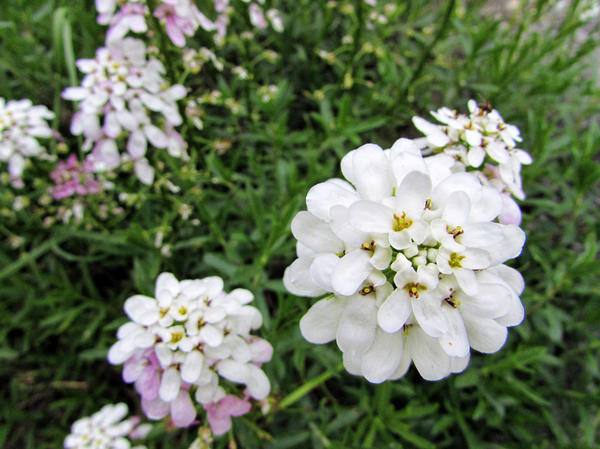 Inflorescences of Seaside lobularia Blossoms for a very long time, throughout the summer and until late autumn, produces a very pleasant honey aroma. After a haircut, it easily recovers and continues to delight with its flowering. It has varieties and varieties, it is they who are widespread among flower growers.
Inflorescences of Seaside lobularia Blossoms for a very long time, throughout the summer and until late autumn, produces a very pleasant honey aroma. After a haircut, it easily recovers and continues to delight with its flowering. It has varieties and varieties, it is they who are widespread among flower growers.
Bentham's group
- 'Wise Risen' variety. A compact bush up to 35 cm high covered with large white flowers.
- The ‘Schneesturm’ variety. Smaller plant - up to 25 cm, flowers as in the previous variety.
Group of compact varieties
- ‘Violetkonigin’ variety. A very small bush 10-15 cm high, forms many branching shoots, flowers have a purple tint.
- ‘Carpet of Snow’. White, very fragrant flowers on a bush 12-15 cm tall.
 Lilac lobularia
Lilac lobularia
Group of prostrate
- The 'Schneeteppich' variety. Tiny bush, only 8-10 cm in height. White flowers form shortened brushes.
- ‘Rosie O’Day’. The baby is 8-10 cm tall, the flowers have a rich pink color.
- 'Kenigsteppih' variety. A small plant, all covered with purple-violet flowers.
Group of variegated
For low (up to 15 cm) plants, leaves with a border along the edge (yellowish or white) and medium-sized flowers of white or light purple color are characteristic.
- ‘Easter Deep Rose’ variety. The youngest variety, the plants are undersized, form bushes, completely covered with bright pink flowers.
- 'New Apricot' variety. The inflorescences consist of flowers, the tips of which are painted in a very delicate pale apricot shade.
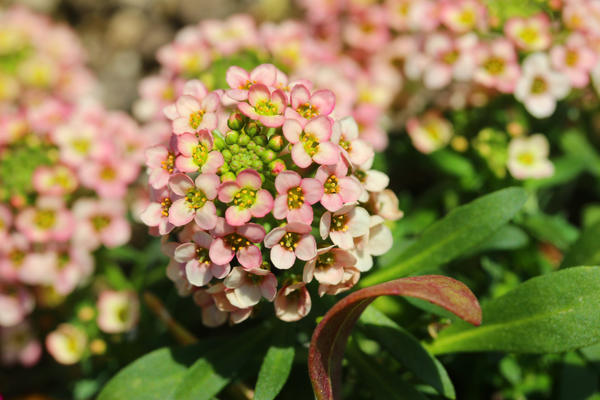 Lobularia apricot flowers
Lobularia apricot flowers
- 'Paletta' variety. This variety has a varied color of petals - different shades of pink and deep crimson, also lilac and even brown.
- ‘Salmon’ variety. Small bushes 10 cm high, decorated with trendy salmon pink inflorescences.
- 'Tiny Tim' variety. Just a dwarf (up to 8 cm) with creeping shoots, it looks like a ground cover plant, all covered with dazzling white flowers.
Planting lobularia and caring for it
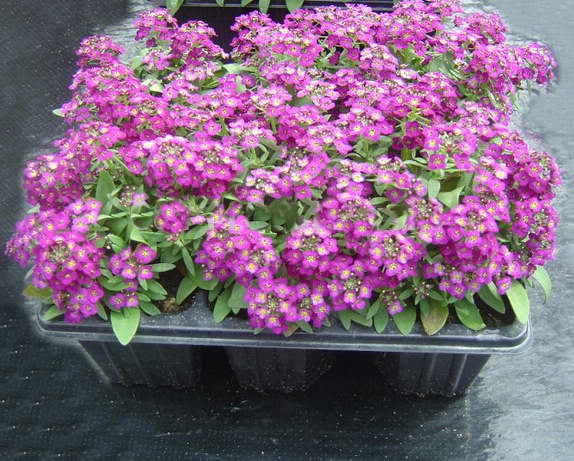
Seedling lobularia ready for planting photo
Seat selection
The sunniest, open and warmest area is suitable for lobularia. Cold and damp areas should be avoided. There are no requirements for nutritional value, acidity or composition of the soil. Only the soil should not become waterlogged and waterlogged.
Landing
Dig the soil well, make small holes and plant a lobularia, keep a distance of 15-20 cm between the plants. In cramped conditions, the lobularia will grow poorly and be susceptible to diseases.
Watering and feeding
The plant is unpretentious in care, does not require special efforts. It basically comes down to pruning. Even the most careful maintenance and regular watering will not be able to prolong the first wave of flowering if the summer is simply dry and hot. Lobularia growing in open ground is watered only in extremely dry and hot months, you also need to water the seedlings for the first two weeks after planting in the ground.
You can also forget about plant nutrition. Lobularia is content with the supply of nutrients in the garden soil and does not like excess fertilizers.
Pruning
When the first wave of flowering stops at the lobularia, it must be cut off. Cut the bush low, the plant will quickly grow again, the splendor of the bush will be restored and the lobularia will bloom again on the eve of autumn. Varieties have been bred that do not require pruning, they are able to renew on their own. When buying seeds, clarify these nuances.
Caring for container plants

How to care for ampelous lobularia photo
Caring for container and pot lobularia requires a little more effort. They need to be watered regularly, fertilized every week, and thin and loose shoots should be cut off in time. But compared to other annuals, caring for the potted form of this plant is quite simple.

